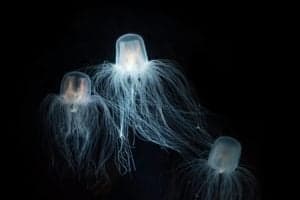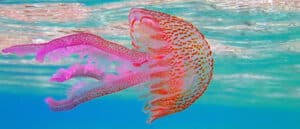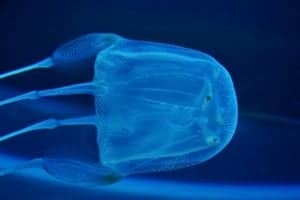Groundbreaking research conducted on Caribbean box jellyfish has shown that you don’t need to have a brain to be intelligent! The findings of the study have recently been published in the journal Current Biology and it was conducted by scientists from Germany and Denmark. Up until now, it was thought that only animals with advanced nervous systems could participate in advanced learning. Therefore, jellyfish with a primitive nervous system could only demonstrate the simplest forms of learning. However, this research has indicated that jellyfish can learn from their mistakes! The animals in the study were able to change their behavior based on their previous experiences.
The jellyfish in this study were able to gauge distances. This allowed them to swim away from mangrove roots at exactly the right moment. This enabled them to catch copepods (their normal prey) without bumping into the roots and damaging their delicate bodies. They can combine visual impressions with sensations. Even though they have only 1000 nerve cells and no brain, they can demonstrate what scientists refer to as ‘associative learning’. The researchers hope that these findings will allow them to model the cellular processes of advanced learning and memory formation. This could be vital for studying various forms of dementia in humans.
What Exactly Are Caribbean Box Jellyfish?
The animals in this study are Tripedalia cystophora otherwise called box jellyfish. They are a member of a group of animals known as cnidarians and are thought to be the earliest living animals to develop a nervous system. They are only around half an inch in diameter making them about the size of a human fingernail. The jellyfish have a boxy dome-shaped bell with a flattened top that is a translucent yellowish-brown. Around a quarter of the way up the bell are their light-sensitive cells which were a major part of this research. One colony of the jellyfish lives on the margins of mangrove lagoons in the Caribbean Sea.
How Do Box Jellyfish Normally Feed?
The biology of box jellyfish feeding was crucial to this study. They feed on tiny animals called copepods that are found in sunlit areas amongst the roots of mangroves. Large swarms of copepods can be seen in patches of water illuminated by shafts of sunlight. These jellyfish feed by allowing themselves to sink slowly towards the bottom spreading out their tentacles to catch their prey.
It is thought that they use visual cues to maintain their positions in the shaft of sunlit water. This keeps. them where food is most plentiful. Now that scientists know that jellyfish can learn how to avoid obstacles in the water, the next step is to pinpoint the exact mechanisms involved in their learning.
The photo featured at the top of this post is © Suzan Meldonian/Shutterstock.com
Thank you for reading! Have some feedback for us? Contact the AZ Animals editorial team.







